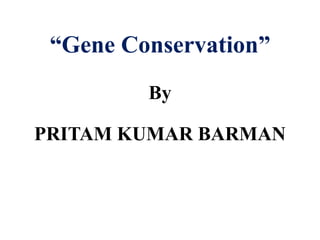
Gene Conservation, Types, Management and Advantages
- 1. “Gene Conservation” I By PRITAM KUMAR BARMAN
- 2. CONTENTS 1. Gene Conservation 2. Factors Affecting Forest Genetic Resources 3. Programs Concerned With Gene Conservation of Forest Trees 4. Management of Genetic Resources of Forest Trees 5. In-Situ Conservation 6. Ex-Situ Conservation 7. Applications of Molecular Markers to Gene Conservation 8. Conclusion
- 3. Gene Conservation Gene conservation, defined as the policy and management actions taken to assure the continued availability and existence of genetic variation (FAO, 2001), is an essential component of sustainable forestry. Genetic variation is at the core of a species adaptive value; it allows them to develop their unique adaptations and assures their survival in changing circumstances. The conservation of Forest Genetic Resources has received potential attraction both nationally and globally due to their productive, economic, environmental and other service roles. The conservation of Forest Genetic Resources is approached by two methods viz., In-Situ and Ex-Situ conservation.
- 4. Factors Affecting Forest Genetic Resources Forest Genetic Resources are the heritable materials that are maintained within and among trees and other woody plants which are of actual or potential, economic, environmental, scientific and societal values. FAO (2014) has identified the major factors that are responsible for loss of Forest Genetic Resources, they are: I. Conversion of forest for agriculture and allied activities. II. Conversion of forest for industrial plantations. III. Increasing demand for energy. IV. Unsustainable harvest and utilization. V. Growing cattle population. VI. Climate change. VII. Climate impact on species and ecosystem. VIII. Epidemic status of pest and diseases. IX. Change in fire regimes. X. Invasive species. XI. Genetic pollution.
- 5. Programs Concerned With Gene Conservation of Forest Trees CAMCORE: International Tree Conservation and Domestication, established in 1980. CGIAR: The Consultative Group on International Agricultural Research is a large research organization created in 1971. DFSC: The DANIDA (Danish International Development Agency) Forest Seed Center, in operation since 1969. EUFROGEN: The European Forest Genetic Resources Programme, established in 1995. FAO: Food and Agriculture Organization provides technical and scientific support to countries on all aspects of forest gene conservation. ICRAF:
- 6. (Source: FAO.org, Palmberg-Lerche 1998) Management of Genetic Resources of Forest Trees
- 7. In-Situ Conservation In-Situ is the conservation in natural, original place or position. It includes conservation of plants and animals in their native ecosystem where they naturally occur. This is commonly practiced for wild flora and fauna and not to the domesticated plants and animals. This type of conservation is aimed at protection and preservation of land races, wild relatives, wild forms etc.
- 8. Strategies for In-Situ Conservation National Park National Monument Wildlife Sanctuary Cultural Landscape Biosphere Reserve
- 9. The species will have all the resources that it is adapted to. The species will continue to evolve in their environment. Applicable to species with orthodox and recalcitrant seeds, and to vegetatively propagated species. The species have more space. Bigger breeding populations can be kept. It is cheaper to keep an organism in its natural habitat. Advantages of In-Situ Conservation
- 10. Ex-Situ Conservation Ex-Situ Conservation is the preservation of components of biological diversity outside their natural habitats. This involves conservation of genetic resources, as well as wild and cultivated or species, and draws on a diverse body of techniques and facilities. Such strategies include establishment of Botanical gardens, zoos, conservation stands and gene, pollen, seed, seedling, tissue culture and DNA banks.
- 11. Strategies for Ex-Situ Conservation Seed Gene Bank Gene Bank Cryopreservation Tissue Culture Bank Long Term Captive Breeding Botanical Gardens Zoological Gardens Animal Translocation
- 12. It is useful for conserving the declining population of species. Endangered animals on the verge of extinction are successfully bred. Threatened species are bred in captivity and then released in the natural habitats. Ex-situ centres offer the possibilities of observing wild animals, which is otherwise not possible. It is extremely useful for conducting research and scientific work on different species. Advantages of Ex-Situ Conservation
- 13. Applications of Molecular Markers to Gene Conservation When it comes to forest tree gene conservation, molecular markers have a wide range of uses. They can assist in the delimitation of species and subspecies at the broadest level. Molecular markers (especially allozymes) have been frequently used to define patterns of genetic variation within species. When assessing the proper number and location of conservation populations, the patterns are frequently used as a baseline. (Source: Dar, Aejaz & Mahajan, Reetika & Sharma, Susheel. (2019). Molecular markers for characterization and conservation of plant genetic resources. Indian Journal of Agricultural Sciences. 89. 1755-1763.)
- 14. Conclusion The Forest Genetic Resources are valued for their economic, environmental and ecosystem benefits. However they are under tremendous pressure due to the rapid rate of deforestation, habitat alteration and indiscriminate extraction of forest products. These activities have endangered large number of species and some of them have drive to a stage of extinction. Both in-situ and ex-situ gene conservation require long-term strategies to ensure effective conservation efforts. One major issue with in-situ conservation is that it often saves the wrong forest populations. The selection of stands for in situ conservation must be done with extreme care. Ex-situ conservation can be expensive, but they are preferred when: The species is being domesticated through a tree improvement program that can actively manage the gene conservation effort; In-situ gene conservation reserves would be difficult to protect from threats.
- 15. REFERENCES 1) T.W. White, W.T. Adams and D.B. Neale (2007). Forest Genetics, CAB International. 2) Zobel, B., and Talbert, J. (1984). Applied Tree Improvement, John Wiley & Sons.
